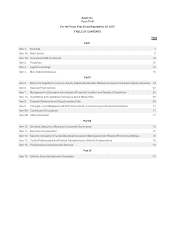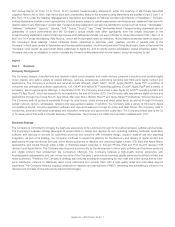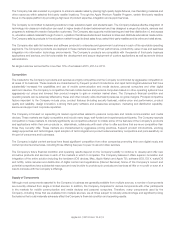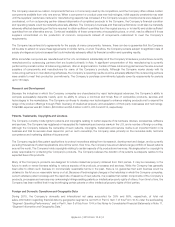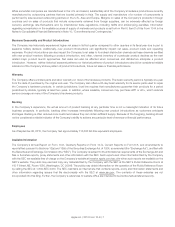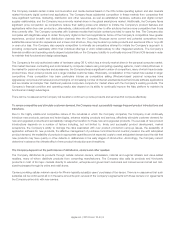Apple 2015 Annual Report Download - page 11
Download and view the complete annual report
Please find page 11 of the 2015 Apple annual report below. You can navigate through the pages in the report by either clicking on the pages listed below, or by using the keyword search tool below to find specific information within the annual report.The Company markets certain mobile communication and media devices based on the iOS mobile operating system and also markets
related third-party digital content and applications. The Company faces substantial competition in these markets from companies that
have significant technical, marketing, distribution and other resources, as well as established hardware, software and digital content
supplier relationships; and the Company has a minority market share in the global smartphone market. Additionally, the Company faces
significant price competition as competitors reduce their selling prices and attempt to imitate the Company’s product features and
applications within their own products or, alternatively, collaborate with each other to offer solutions that are more competitive than those
they currently offer. The Company competes with business models that include content provided to users for free. The Company also
competes with illegitimate ways to obtain third-party digital content and applications. Some of the Company’s competitors have greater
experience, product breadth and distribution channels than the Company. Because some current and potential competitors have
substantial resources and/or experience and a lower cost structure, they may be able to provide products and services at little or no profit
or even at a loss. The Company also expects competition to intensify as competitors attempt to imitate the Company’s approach to
providing components seamlessly within their individual offerings or work collaboratively to offer integrated solutions. The Company’s
financial condition and operating results depend substantially on the Company’s ability to continually improve iOS and iOS devices in order
to maintain their functional and design advantages.
The Company is the only authorized maker of hardware using OS X, which has a minority market share in the personal computer market.
This market has been contracting and is dominated by computer makers using competing operating systems, most notably Windows. In
the market for personal computers and accessories, the Company faces a significant number of competitors, many of which have broader
product lines, lower priced products and a larger installed customer base. Historically, consolidation in this market has resulted in larger
competitors. Price competition has been particularly intense as competitors selling Windows-based personal computers have
aggressively cut prices and lowered product margins. An increasing number of internet-enabled devices that include software applications
and are smaller and simpler than traditional personal computers compete for market share with the Company’s existing products. The
Company’s financial condition and operating results also depend on its ability to continually improve the Mac platform to maintain its
functional and design advantages.
There can be no assurance the Company will be able to continue to provide products and services that compete effectively.
To remain competitive and stimulate customer demand, the Company must successfully manage frequent product introductions and
transitions.
Due to the highly volatile and competitive nature of the industries in which the Company competes, the Company must continually
introduce new products, services and technologies, enhance existing products and services, effectively stimulate customer demand for
new and upgraded products and successfully manage the transition to these new and upgraded products. The success of new product
introductions depends on a number of factors including, but not limited to, timely and successful product development, market
acceptance, the Company’s ability to manage the risks associated with new product production ramp-up issues, the availability of
application software for new products, the effective management of purchase commitments and inventory levels in line with anticipated
product demand, the availability of products in appropriate quantities and at expected costs to meet anticipated demand and the risk that
new products may have quality or other defects or deficiencies in the early stages of introduction. Accordingly, the Company cannot
determine in advance the ultimate effect of new product introductions and transitions.
The Company depends on the performance of distributors, carriers and other resellers.
The Company distributes its products through cellular network carriers, wholesalers, national and regional retailers and value-added
resellers, many of whom distribute products from competing manufacturers. The Company also sells its products and third-party
products in most of its major markets directly to education, enterprise and government customers and consumers and small and mid-
sized businesses through its online and retail stores.
Carriers providing cellular network service for iPhone typically subsidize users’ purchases of the device. There is no assurance that such
subsidies will be continued at all or in the same amounts upon renewal of the Company’s agreements with these carriers or in agreements
the Company enters into with new carriers.
Apple Inc. | 2015 Form 10-K | 9


